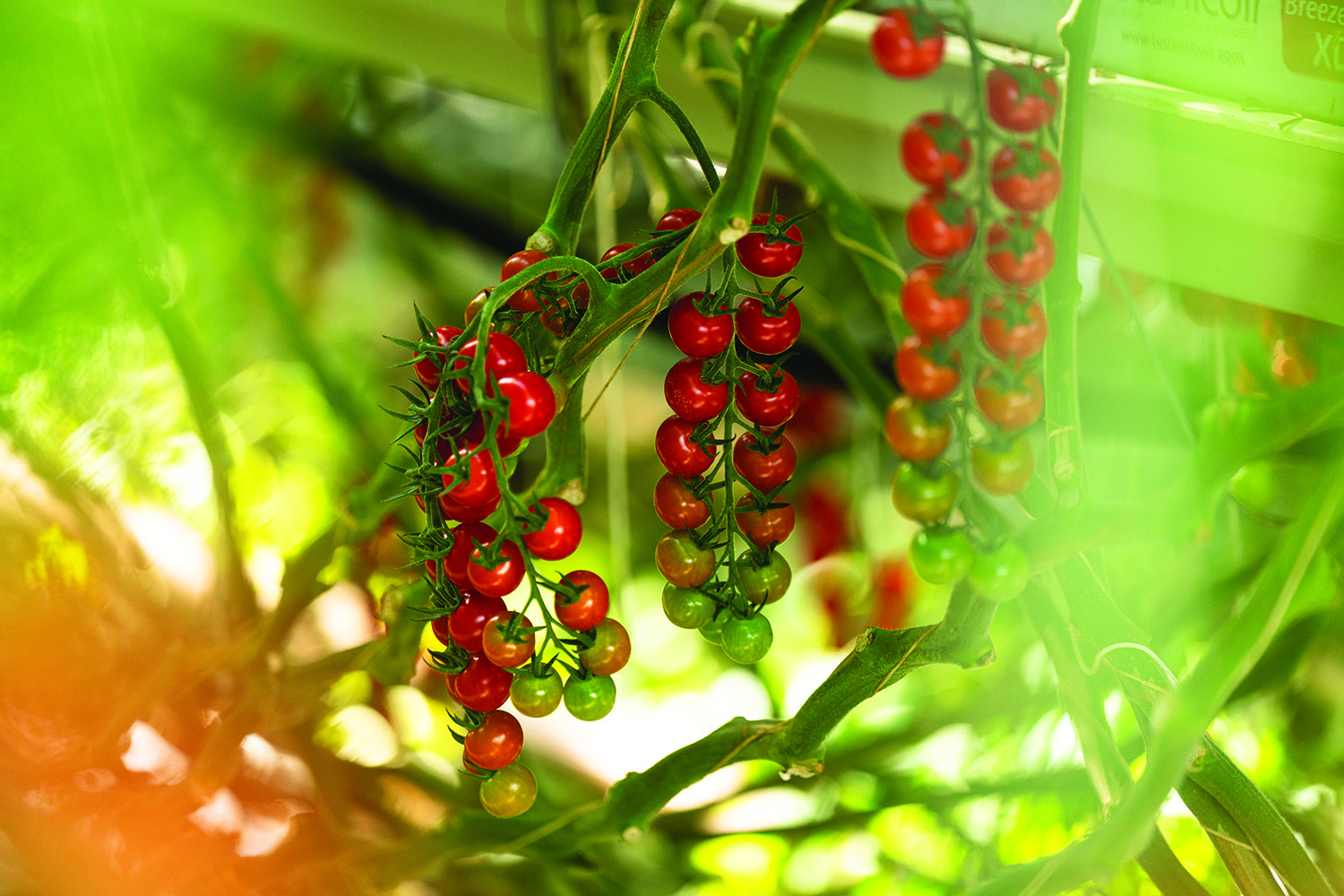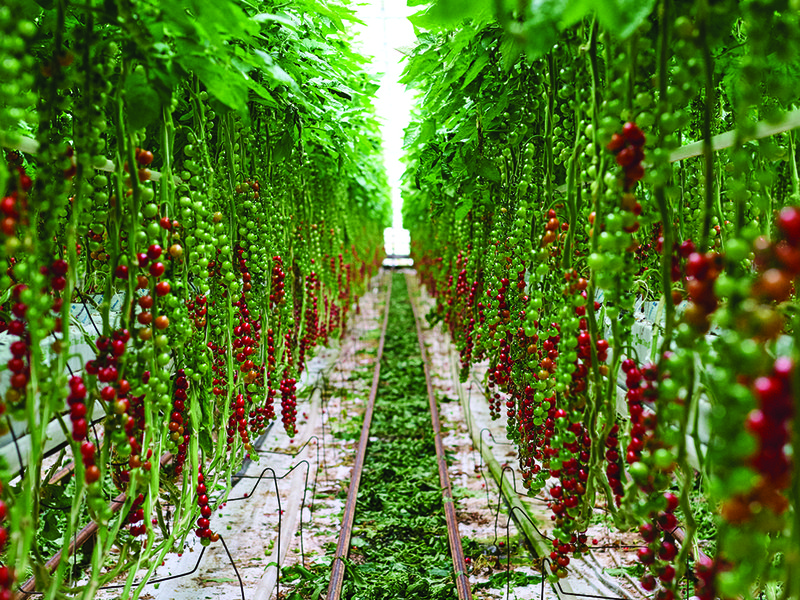The Isle of Wight forms a diamond in the English Channel, about three miles off the south coast of mainland Britain. Its shape and position are such that clouds tend to disperse overhead as they drift in from the Atlantic, letting abundant natural light shine through. This is indeed the sunniest spot in the UK, with a unique microclimate where the surrounding sea intensifies that light by reflection while insulating the interior from winter cold snaps and summer heatwaves. All of which, says Paul Thomas, makes it perfect for growing tomatoes.
Paul is managing director of Isle of Wight Tomatoes, based close to the centre of the island on a site that covers 27 hectares of glasshouses, all producing variations of that one particular fruit. “We grow conventionally, and organically,” he says, “but our main point of difference is flavour. It’s all about growing premium tomatoes that taste great.” And the best way to do this – though many producers do not – is to leave them on the plant as long as possible, “so they can fully ripen and really develop that flavour.”
Commercial tomato farming began on the island in the 1960s, and a few greenhouses from that period still operate today, as well as the ever-more extensive facilities built in the 80s, 90s and 2000s. Paul’s own story begins circa 2007, he says, a period when the British general public had “fallen out of love with tomatoes” because of the generally bland options then being sold in most supermarkets.
“Around then we started a pilot development programme that had us growing 150 to 200 different varieties, but we didn’t really have a home for them. The UK food scene was changing at the time, with small artisan markets opening here and there, and one of them was the Borough Market in London. So we hatched a plan to bring our tomatoes direct to the consumer there, and people just went mad for them because we were trialing these varieties that were packed with flavour. We’d congregate every Saturday morning in London with all these new artisan producers of cheese and meat, and this big foodie customer base would come down, and we’d have all the celebrity chefs buying from us.
“At that point you start to realise that you have something special, and you start developing a business and a brand.” In the years since, Isle of Wight Tomatoes has continued to experiment with “colours, textures, shapes and sizes”, working with seed houses from around the world to test new varietals that might be the next big flavour breakthrough. Contenders are given a season to see how they grow, how they hold up to pests and diseases, and how they taste according to an expert panel convened every summer.
A good score might mean a larger-scale trial before a final decision is made on taking that tomato to market. Recent graduates of note include a beef tomato that shows pineapple-yellow on the outside then deep red when you cut into it, and a pink tomato from a Japanese breeding programme with an especially thin skin.
“But sliced open with a bit of oil and salt, it’s almost a meal in itself,” says Paul. Not having much of a sweet tooth, his own taste leans toward the bigger and more savoury varieties, but any tomato in the Isle of Wight range has been cultivated with what he calls the “meal experience” in mind. “Take a mixed pack of six varieties, and each one will have its own characteristics, but you can cook with any of them. We’re trying to change people’s perception of tomatoes as something you just have on the side or in a salad.”
Several of the most popular types grown here are shipped out to Spinneys, including large vine, cherry-on-the-vine, and large plum tomatoes as well as “speciality products” like heritage beefsteaks. “We send you some of the interesting tiger and brown tomatoes, too. Spinneys gets a real showcase selection of what we do in terms of flavour.”
When it comes to the actual growing, another Paul – Paul Howlett – has developed his expertise in that area over 37 years. “When I started out there were only about two and a half hectares of old glass for growing in here, and I thought I’d only be doing it for a few weeks,” says Paul. “Since then I’ve done every job there is. Picking, training, trimming … I’ve been up there cleaning the glasshouse roofs.” And for the last 15 years he’s been head of production at Isle of Wight Tomatoes, overseeing both conventional and organic crops.
The former are ripened inside grow-bags and fed everything they need, while the latter grow in certified-organic soil, taking all their nutrients the natural way – no artificial elements allowed. Without recourse to pesticides, says Paul, “we’ve done a lot of work over the years with biological control.” Another way to put this: “Using good bugs to control bad bugs.”
He holds up a sachet labelled Encarsia Formosa, which contains the eggs of a particular parasitic wasp used to control whitefly. “We introduce these to the plants every week through the season, and they hatch and go hunt for the bad guys.” But the truly indispensable heroes of the glasshouse are the bumblebees, without whom “there would be no tomatoes.”
“They do all the pollination here, and we’ve been using them for about 30 years. Before that, we used to do it all by hand, shaking all the pollen out of the plants ourselves. But now the bees do that for us, and they do a much better job than we ever did.”
Another key point of difference between Isle of Wight Tomatoes and most other producers, says Paul, is the soil-deep sustainability of the process itself. There is no such thing as crop rotation here, as one harvest follows another, “always tomatoes after tomatoes.” “And the way we manage the soil, we are growing healthier crops every year.” The company makes all its own compost from all its own waste, uses biological string where other growers use plastics, and it also sources sustainable coir for conventional tomatoes – the outer husk of coconut shells from a specialist provider in Sri Lanka,
“It has no nutritional value, we supply all that anyway, but it’s got a very good air-to-water ratio that helps the roots to grow. It works very well in compost, too, mixed in with the plant and some old palettes to give it a good carbon source. Composting is like a recipe that you mix at different ratios to go back into your organic soils and produce the best crops.”
The water used here comes from falling rain – sunny as it is, the island gets plenty – all harvested from the glasshouse roof and reservoirs that fill up through the wetter months, to be used in the main growing season. “In conventional production we water to excess so we always get some drain, which we collect, pasteurise and mix with more rainwater to get the nutrition levels right and put back onto the crop.”
Paul can talk a visitor through the whole cycle with a gentle, pastoral note of devotion to his life’s work: how the individual seeds are grafted, sewn and spliced, how the 50-day-old plants are arrayed through the glasshouses to flower within a couple of weeks and left to ripen for 10 or 12 weeks before harvesting. The conventional “lit” crops are planted earlier than the “unlit” – as early as September – in custom glasshouses that were the first in the UK to operate with an all-LED lighting system back in 2015.
“We’ve been growing very good crops with those LEDs every winter since, when our limiting factor in the UK is obviously natural light.” Picture the Isle of Wight at night, then, in the darkest, coldest months: a full moon shining on that diamond island in a black sea, and right at its heart a glasshouse glowing like a lantern, and inside a festival of fruit growing in all the colours of Christmas, the best tomatoes to be found anywhere on this line of latitude.

Produce commercial manager
Neil Gibson says
We started working with Isle of Wight Tomatoes just last year. We were immediately impressed by their eclectic mix of tomatoes – the colours, the varieties, the flavours… we’d never seen all this before. We recently had an amazing sampling session with the team – where we benchmarked our current range with them – testing for flavour and eating enjoyment, while also picking special new varieties. Winners to look out for at Spinneys soon are a Golden Cœur De Bœuf tomato – with beautiful pink marbling and hints of melon with citrus notes; the Wabi Sabi tomato which is like eating a Bolognese sauce – I was blown away by this one; and the Fuji tomato which is juicy, robust and has a real depth of flavour.











